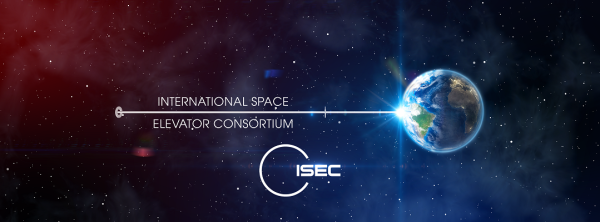|
Welcome to the December 2019/January 2020 Edition of the ISEC Newsletter
In this Issue:
Editor’s Note
President’s Corner
ISEC Success at the International Astronautical Congress
Architecture Note
Summary Record of Space Elevator News at the International Astronautical Congress
Graphene Industry Showcase
ERE Mystery Solved
Reinventing Space Conference
History Corner
Call for Volunteers—Two Study Introductions
Upcoming Events
Dear Fellow Space Elevator Enthusiast,
Due to the holidays and this being a generally busy time of year, (including my wedding anniversary) this newsletter will function as our December 2019/January 2020 Newsletter! I will enjoy a break from publishing and be at a party until 12:30 AM on January 1st! And, since I won't be publishing again between now and February, let me say, "Happy Solstice, Happy Hanukkah, Merry Christmas, Happy Kwanzaa, Happy Boxing Day, Happy New Year, Happy Epiphany, and if I missed your favorite...Happy Holidays!"
Please like us on Facebook, follow us on Twitter, and check in on our website for updates.
Sandee Schaeffer
Newsletter Editor
President's Corner
by Pete Swan
ISEC Goals 2020
As 2019 is rolling out and 2020 challenges us, I thought I would lay out a few of my goals for our next year. As many of you know we are "upgrading" our website and working on the presentation as well as the content. One task I have is to present a "Strategic Plan" to the board that is current. Within that plan will be the following goals:
Goal One: Continue to expand the knowledge base surrounding the space elevator community. This would include:
- Publishing yearly Position Papers studies (ISEC) such as the two 2020 approved studies: "Beneficial Environmental Impacts of the Space Elevator" and "Interplanetary Mission Support with Space Elevator Infrastructures."
- ISEC support to multiple research projects currently being pursued, such as: Single Crystal Graphene as the tether material, Multiple Stage Space Elevator prototypes, Cloud based space elevator simulation, Earth Port concept refinements, Mars habitation using space elevators, tether climber focused pursuits, and tether climber competitions.
- Attract funding to support space elevator research and development
Goal Two: Continue to interface with the public and spread the word that space elevator infrastructures are required as a complementary capability to rockets for massive movement off-planet.
- Participate in conferences such as ISDC (Dallas end of May), IAF (Dubai Oct), and make our presence there known.
- Produce another webinar.
- Continue good relationship with Japanese Space Elevator Association
- Continue good relationship with National Space Society
Goal Three: Strengthen our Organization
- Continue our monthly newsletter to "bring us together"
- Pull together a more effective public website to propagate our messages
- Increase membership
- Foster relationships with other organizations
- Increase social media reach
- Expand our History Committee activities
Please consider volunteering for any of the above activities by contacting me at Pete.swan@isec.org
home
ISEC Success at the International Astronautical Congress
Washington, D. C. 21-25 October, 2019
by Pete Swan
The involvement of the ISEC with the International Astronautical Congress has been historic. There has been at least one technical session at each of the Congresses dating from 2004. Significant participation has come from ISEC members and friends over the years addressing all aspects of space elevators. This year was a highlight as we had great success with our position papers and website content in real time in front of the international space community. Indeed, the "I" in the ISEC name has matured over the years, but was particularly more visible this time. Please talk to your compatriots who were there to gain the specifics, but the successes spanned all four areas below:
Technical and Architectural Presentations: There were seventeen papers presented in the Space Elevator technical session that reached across all of the topics. Michael Fitzgerald lead the technical papers with one discussing the technical maturity and developmental readiness of SEs. With two papers on the concept of interplanetary "fast transit" departing from a SE Apex Anchor, the topic was kicked off with a series of intriguing statements, to include a bus schedule to Mars and a fast transit of only 77 days. There were many other papers dealing with modern day space elevators, lead by Dr. Knapman and Dr. Ishikawa. Indeed, this technical session took the space elevator concept to a higher level within the international community.
Today's Space Elevator: This ISEC study report (result of the 2019 efforts) was distributed by Pete Swan to several industry experts such as - Dr. Ishikawa, Leonard David, Jerome Pearson, John Knapman, Ken Dividian, Fitzer for distribution to his contacts, and several others. The ISEC team each carried a copy of the book with them as they spoke to other experts from around the world. They showed them the book, explained that it was a "status report" on space elevators as of the fall of 2019, and informed them how they could get copies of their own.
Road to the Space Elevator Era: This International Academy of Astronautics study report (4 years by 30 global space experts) was "released" during the IAC at the Robert Heinlein Prize Trust Booth (publisher). The report has significant inputs from ISEC and our members. Several of the ISEC concepts from our Chief Architect were accepted into the book and stood tall. These would include several of Fitzer's Architectural Notes and his concept of a Galactic Harbour being a combination of a transportation infrastructure and an enterprise zone. This internationally endorsed study report again portrays an aggressive approach towards implementation of SEs. ISEC was instrumental in the content of the book and the editing of the content - as such, this year's distribution of the document at the IAC was a "win-win."
Leave-behinds: This year ISEC put more effort into the outreach for the organization and the Space Elevator. Sandee and Fitzer prepared a few different types of hand outs and leave behinds which were distributed around the venue.
These included:
- Business card size - "Join ISEC"
- 1/3 page two-sided "Here is ISEC"
- Three-fold fliers on Galactic Harbours
The Heinlein Prize Trust was also giving away the "Road to Space Elevator Era" in PDF.
Now we will wait and see how the interest in our website increases and how many new members join ISEC.
Space Elevator Leadership at IAC 2019, Washington D.C.
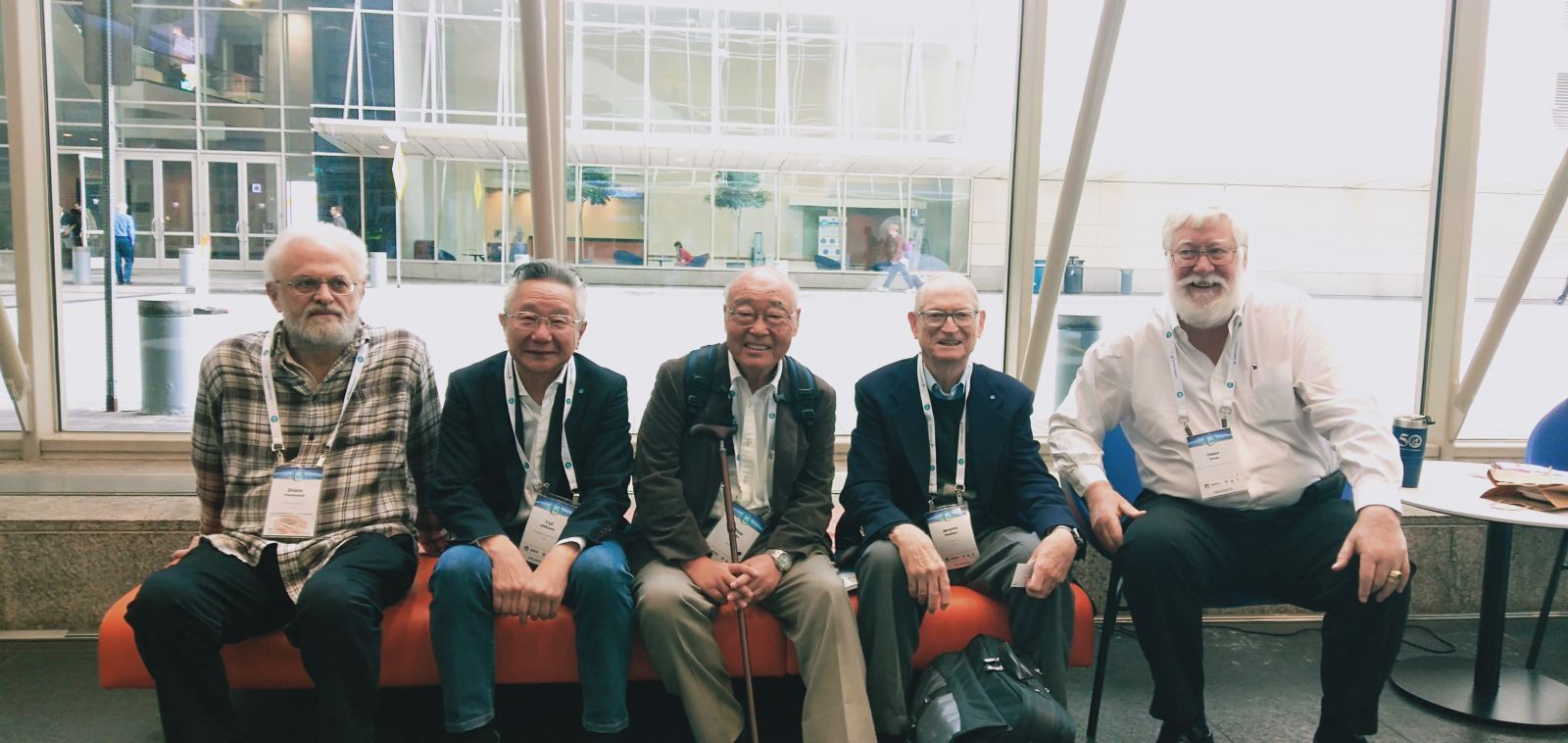
(LtoR) Bruce MacKenzie, Yoji Ishikawa, Tetsuo Yasaka, Jerome Pearson, Peter Swan
photo credit:
home
Space Elevator Architecture
Architecture Note #28
Coming Attractions for 2020
2019 was the “break out” year. The next few Architecture Notes will put some kindling out for 2020…
Coming Attractions for
The Year of Space Elevator Development Catches Fire
Personal Prolog
This is an Architecture Note. It is the opinion of the Chief Architect. It represents an effort to document ongoing science and engineering discussions. It is one of many to be published over time. Most importantly, it is a sincere effort to be the diary, or the chronicle, of the multitude of our technical considerations as we progress; along the pathway developing the Space Elevator.
Michael A. Fitzgerald
The notion of a Space Elevator no longer induces wisecracks about elevator music, but…we still have a way to go.
Two things: First, I live in California so I know that the entire notion of something “catching fire” must be handled gracefully; I will do so. Second, there are several topics in the near term that must be defined within the Space Elevator Architecture discussion, and I will introduce these topics as coming attractions in this note. Over the course of the next several months, each will have their own Architecture Note. (No particular order)
• The Space Mosaic
• Space Debris Mitigation
• Transportation System Recovery
• Road Signs
• Free Delivery is an Essential …
• Situational Self Awareness
• Client Services as a system adjunct
• Space Elevator Test Areas
• Enterprise Business Cases
• Environment Protection is a Universe thing
• Calls for Improvement
• Space Elevator Institute
• Five Year Plan
An impressive list, don’t you think?
With mini abstracts
• The Space Mosaic - We are no longer just “going to space”. We will be conducting exploration, research, military operations, interplanetary travel, trade, and commercial enterprises. ISEC envisions Space Elevators servicing the Mission Operations of all of these endeavors; and special Space Elevators will be built to do the special things.
• Space Debris Mitigation – See Architecture Note #25. The new note will cite how the Space Elevator will handle the current & future issues of Debris Management. It will discuss how the elevator will be protected from collisions.
• Transportation System Recovery – The discussion on Space Debris suggests that maybe, just maybe, the Elevator’s tether can be severed. A recovery scheme must be developed and made part of Space Elevator at first operations.
• Road Signs – See Architecture Note #26. The note discusses the implementation of the ISEC call for interplanetary bus schedules; with frequent departures established as the norm. It is the ISEC position that limiting flights to Mars (for example) to the special moment every 26 months is not mission enabling.
• Free Delivery is an essential - See Architecture Note # 27. This note calls for focused and collaborative efforts to understand and quantify how Interplanetary missions can be successfully pursued when all mission competencies collaboratively execute the missions. Recently, ISEC has called for three particular “reference missions” that represent the essence of interplanetary space travel.
• Situational Self Awareness - a future Architecture Note will discuss how the Space Elevator Transportation System will keep track of all components of the architecture; from Climbers to all pieces of cargo, to objects “passing through” the Regions on high. Thousands of objects must constantly and continuously be registered and tracked!
• Client Services Adjunct – a coming Architecture Note will examine how the system manages entry to the Elevator and sustains an efficient flow of Climbers with cargo ascending the tether. Also, the Space Elevator Transportation System cannot accept a client’s cargo without some assessment that it will rise to its destination without a bad outcome. Damage to the cargo is not acceptable, nor is cargo damaging the Elevator acceptable.
• Space Elevator Test Areas – ISEC has been clear for the last six years; “show me”. The manifestation of that approach has been cited in rather succinct ways. ISEC proposes that, throughout the Engineering Validation and the Design Validation phases, extensive tests and demonstrations will be needed. Further, the next test or demonstration will be larger than the last one. Finding and building those test areas will be a challenge; let’s talk.
• Enterprise Business Cases – There are any number businesses that would like to operate within the GEO region. How might “entrance requirements” be levied for those businesses needing operational space at GEO, and operations support from the Elevator.
• Environment Protection is a Universe thing – The one thing we learned in the 20th Century is that protecting the environment is not an extracurricular activity; it is foundational. The Space Elevator Transportation System has a great opportunity to make the Earth “greener”; it should do so!
• Calls for Improvement – In many ways, the development of the Space Elevator Transportation System is like any of the mega engineering projects that preceded it. The development team will learn new engineering ways and hone special engineering solutions. We will not be shy; we will “call” for such things; hence the phrase “Call for Improvement”. Improvements will enable a new tether, a bigger Climber, more throughput, or special handling special cargo; all because the Space Elevator is contributing to and building the Space Mosaic – the best way we know how.
• Space Elevator Institute – There is one major step that can be initiated in the near term to significantly move the Space Elevator forward. The establishment of a Space Elevator Institute would focus many of the issues for discussions, research, analysis and recommendations. The Space Elevator Institute focus will identify and study the vast array of questions still to be answered.
• The Five-Year Plan -- There are actually two 5-year plans. One for the Space Elevator as it progresses through the early parts of Engineering Validation; and one for ISEC as it progresses toward establishing the Space Elevator Institute.
These topics just reveal how much engineering work and analysis awaits us. It is not to be ignored or dismissed. It is our lot; because we care so.
In Closing
I don’t mean to imply that this is the complete list. Add to the list, if you wish. After all is said and done; a hell of a lot more is said than done; and that ain’t us! Just saying.
Fitzer
Michael A. Fitzgerald
Senior Exec VP and Co-Founder
Galactic Harbour Associates, Inc
Space Elevator Transportation & Enterprise Systems
home
Summary Record of Space Elevator News
by Michael Fitzgerald
International Astronautical Congress
Washington D. C.
21 to 25 October 2019
1. IAA publication officially released --> “Road to the Space Elevator Era”
2. ‘Standing Room Only’ during the Space Elevator Track presentations
3. International Space Elevator Consortium (ISEC) announces that the Space Elevator Transportation System concept is “Tech Ready”; i.e., ready for engineering validation.
4. ISEC releases key 2019 report; “Today’s Space Elevator”. The report substantiates “Tech Ready”, citing that its baseline transportation concept passes “preliminary” Technology Readiness Assessment. The report cites an extended volume of publications and assessments.
5. ISEC released key analysis of new “Pathways” to Mars. The study, conducted at Arizona State University and led by ISEC’s President, reveals that flights to Mars can be as short as 77 days (versus 8 months); and departures are possible essentially daily (versus the narrow “efficient” departure window that occurs every 26 months).
6. Logistical needs for Mars and Moon missions require daunting launch schedules to meet support requirements cited to date. Thousands of launches of the largest US launchers would be required.
7. Space Based Solar Power sources cited a need of over 5 Million Metric tons to be delivered to geosynchronous orbit. With that, one billion customers would be served. That requirement alone requires over 30,000 launches of (e. g.) SpaceX’s largest launchers.
8. Dr. Swan and Lt Col (Ret’d) Fitzgerald announced their intention to establish the Space Elevator Institute.
Fitzer
home
Graphene Industry Showcase
by Adrian Nixon
The people at the University of Manchester are holding a Graphene Industry Showcase (GIS) event on the 10th and 11th of December at the Graphene Engineering Innovation Centre (GEIC) and the National Graphene Institute (NGI.) I will be there, presenting about the state of the technology and market in graphene at the event. I will also have the privilege of interviewing Andre Geim, the Nobel prizewinning scientist who first isolated graphene, in a rare interview live on stage on the 10th of December.
There is a link for people to post their questions they’d like me to put to him:
https://wakelet.com/wake/12dcf15e-6d96-4ed4-a368-ff79e4a45336
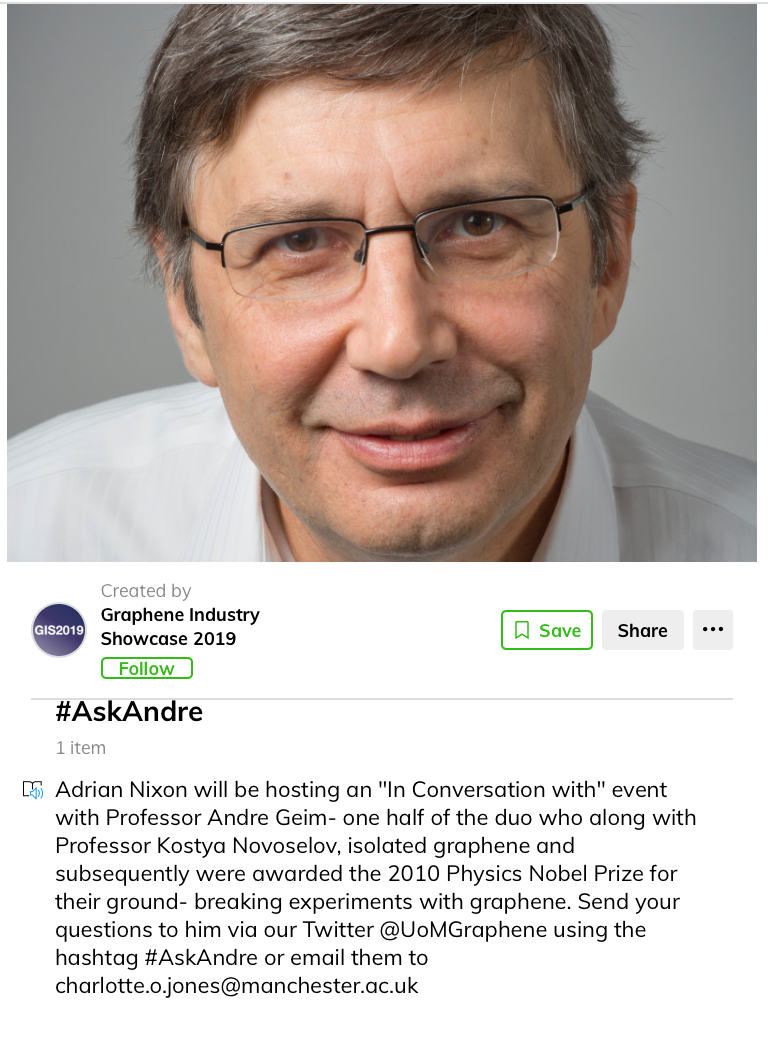
home
The Mystery of the Extended Red Emission (ERE) in the Interstellar Medium – Solved!
by Adrian Nixon

Image source, Pixabay: https://pixabay.com/illustrations/universe-sky-star-space-cosmos-2742113/
There is a mystery out there between the stars. Astronomical observations over the past four decades has revealed a ghostly glow out there.
The interstellar dust in nebulae and in the diffuse interstellar medium of galaxies contains a component which responds to illumination by ultraviolet photons with efficient luminescence in the 500 nm to 1000 nm spectral range, known as Extended Red Emission (ERE) [1].
The best guess anyone had was the ERE feature was attributed to luminescence of dust grains, possibly nanoparticles with a high surface area. However, until now no-one knew what this actually was.
New work has been done by Professor Peter Sarre at the School of Chemistry, at the University of Nottingham, UK. Peter has conducted thorough lab tests looking at the emission spectra of various candidate materials and he has solved the mystery.
Peter’s work has shown that there is a strong similarity between laboratory optical emission spectra of graphene oxide (GO) and ERE. He proposes that the infra-red emission from GO nanoparticles is the origin of ERE and that these are a significant component of interstellar dust [2]. The proposal is supported by infrared emission features detected by the Infrared Space Observatory (ISO) and the Spitzer Space Telescope
This fascinating work clearly shows that graphene oxide nanoplates are an extensive component of interstellar dust and solves the mystery of the ERE.
So what?
Graphene and graphene oxide are candidate materials for making a space elevator tether.
This finding supports other work that shows graphene is commonplace in space and also demonstrates that graphene and graphene oxide are stable materials that are some of the oldest materials in the universe. [3]
This means that graphene and graphene oxide are incredibly stable materials that can survive the harsh environment of interstellar space. A further reason to consider these materials as candidates for the tether.
References:
1. A. N. Witt, G. C. Clayton, and B. T. Draine (2003) ‘Astrophysics of Dust’, ASP Conf. Proceedings,
https://arxiv.org/abs/astro-ph/0309674 [accessed 3rd November 2019]
2. P.J. Sarre, (2019) ‘Graphene oxide nanoparticles in the interstellar medium’, Monthly Notices of the Royal Astronomical Society: Letters, Volume 490, Issue 1, November 2019, Pages L17–L20,
https://academic.oup.com/mnrasl/article-abstract/490/1/L17/5556554
3. A. Nixon, R. Whieldon, Z. Jarrahi Cinker (2019) ‘Graphene Gateway’ Special edition of the Nixene Journal, made for the American graphene summit, Washington DC
home
Reinventing Space Conference
The Reinventing Space Conference (RIS) took place 12th through the 14th of November in Belfast, Ireland. Our very own Peter Robinson attended and spoke on “Space Elevator History, Status, and Future.” He also met with ISEC intern, Sophia Lee Roberts, who had been nominated for a Student Space Achievement award for, “enthusiasm in participating in space initiatives like the Space Elevator, in running the King’s College London Space Society and her dedication to STEM outreach, particularly the Space Settlement Design Competition and the Galactic Challenge.” They both attended the Sir Arthur Clarke Awards dinner. She unfortunately did not win the award, but we are proud of her, just the same!
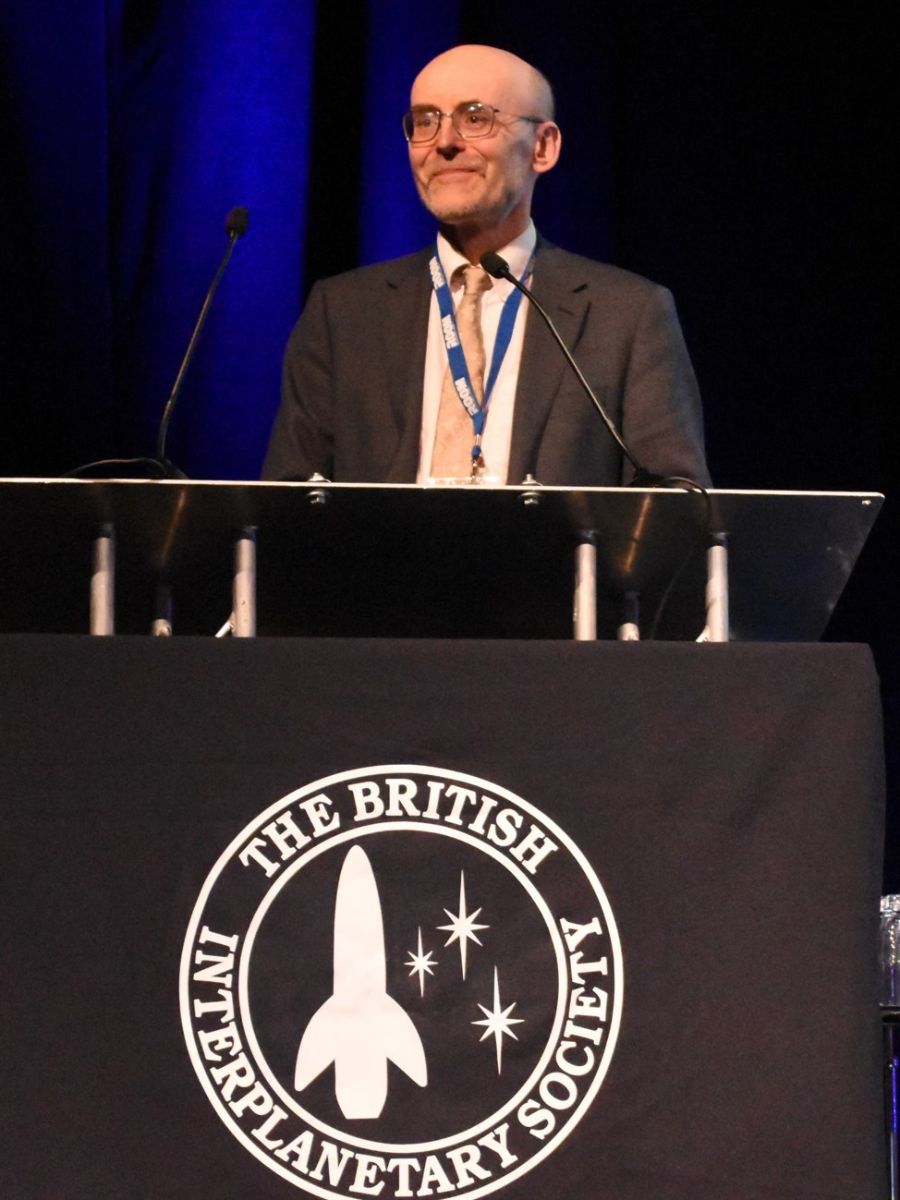
Peter Robinson
photo taken by Geir Engene at the British Interplanetary Society
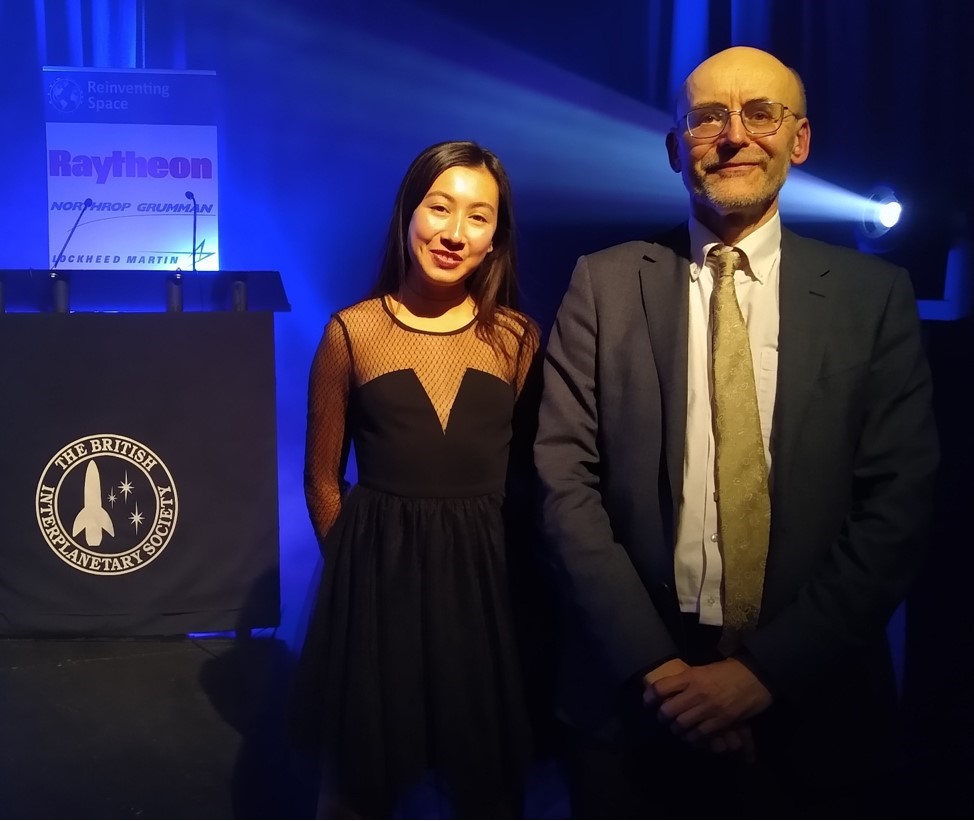
Sophia Lee Roberts and Peter Robinson
photo taken by Evan Meyrick
home
History Corner
by David Raitt
The Contribution of Arthur C. Clarke to the Space Elevator
This essay for the History Corner shows the influence that Arthur C. Clarke has had on the space elevator. His name crops up many times whenever space elevators have been mentioned in the past as well as the present. This is the first part of two parts due to length.
In the mid-to-late 19th century, writers such as Jules Verne and H. G. Wells, began writing adventure stories that featured interplanetary travel. However, Verne was preceded in his imagination of spaceflight by William Leitch, a church minister from Monimail, Fife, Scotland who suggested in 1861 that rockets could fly to the Moon and go faster and smoother in the vacuum of space. In fact, though, both Verne and Leitch were writing two whole centuries after Cyrano de Bergerac, whom Arthur C. Clarke credited with being the first to use rocket-powered spaceflight to the Moon!
In 1966 Russian journalist Vladimir Lvov responded to an article by four American scientists, led by John Isaacs, which discussed making a cable to reach geosynchronous orbit to the effect that Yuri Artsutanov had already developed the concept they proposed and had published his ideas for a ‘heavenly funicular’ in 1960. Science published Lvov’s letter together with a comment from Isaacs and his team in which they agreed that Artsutanov had proposed his sky hook six years before their paper was published. A chapter in a biography of John Isaacs notes the intervention of Lvov and mentions that the idea of a skyhook or space elevator was taken up by science fiction writers, notably Arthur C. Clarke, in Fountains of Paradise. Clarke told much the same story about Isaacs, Lvov and Artsutanov in his own biography by Niel McAleer.
Although Jerome Pearson is credited as the co-inventor of the space elevator (along with Yuri Artsutanov), in fact, according to Arthur C. Clarke in 1981, Pearson himself located at least three other independent originators of the concept, though none prior to Artsutanov’s 1960 paper. Though it is Pearson to whom credit is given for bringing the space elevator first onto the world stage, his work published in 1975 soon found its way into numerous science fiction novels such as Arthur C. Clarke’s The Fountains of Paradise. Published in 1979, this seminal novel is often regarded to be the vanguard in bringing the space elevator to the attention of the wider public readership. Pearson actually provided technical expertise for Clarke when he was writing his science fiction classic as he noted in his keynote presentation at the 2013 annual Space Elevator Conference in Seattle, where he talked at length about his long relationship with Clarke.
The Fountains of Paradise is set in the 22nd century, and in the story engineers construct a rigid connection between a point in geostationary orbit and Sri Kanda - a mountain on a fictitious island (Taprobane) closely resembling Ceylon (Sri Lanka) where Clarke lived. One of the major problems for a space elevator is a suitable material able to withstand the mechanical tensile forces which would tear the cable apart. In the novel, Clarke envisions a microscopically thin but strong hyperfilament that makes the elevator possible. Although the hyperfilament is constructed from ‘continuous pseudo-one-dimensional diamond crystal’, Clarke later expressed his belief that another type of carbon, Buckminsterfullerene, would play the role of the hyperfilament in a real space elevator.
Clarke had clearly been thinking about the system he would eventually name the space elevator for some time before he wrote Fountains of Paradise. In 1977, for instance, Hans Moravec outlined the concept and configuration for non-synchronous orbital skyhooks for the Moon and Mars. Expanding his ideas a year or so later Moravec went on to say that Arthur C. Clarke had suggested that Deimos, 3,000km above synchronous orbit, was in exactly the right place to provide a mass anchor for a truncated martian skyhook and using it would permit a skyhook with one third the mass of an equivalent full length cable.
Besides writing his novel in 1979, Clarke, also made a presentation in 1979 at the 30th International Astronautical Congress in Munich on the topic “The Space Elevator: ‘Thought Experiment”, or Key to the Universe?” His paper (published in 1981) was essentially a semi-technical survey of the rapidly expanding literature of the subject, with some speculations about ultimate developments. Whether or not the space elevator could be actually built, it was, nevertheless, of great interest as the only known device which could replace the rocket as a means of escaping from the Earth. If it was ever developed, it could make mass space travel no more expensive than any other mode of transportation. Clarke said what he wanted to talk about was a space transportation system so outrageous that many of the audience might consider it not even science fiction, but pure fantasy. Perhaps it was; only the future would tell. Yet even if it was regarded as no more than a 'thought-experiment', it was one of the most fascinating and stimulating ideas in the history of astronautics.
Clarke went on to consider the problem of nomenclature - what should the space elevator be called: “The Russian inventor used the charming 'heavenly funicular'. American writers have contributed 'orbital tower', 'anchored satellite', 'beanstalk', 'Jacob's Ladder’ - and, of course, 'Skyhook'. I prefer 'space elevator'; it is euphonious (at least in English) and exactly describes the subject.” Clarke’s presentation also gave a historical overview of the salient points and people in space elevator concepts and developments up to that point in time (i.e.1979) - starting with Tsiolkovsky, and including others, such as Isaacs, who were considering extremely long cables for other applications such as deep sea oceanography. He discussed the problem of materials and gave examples of substances that might possibly be used, before moving on to the deployment of the cable and the mass anchor. In his wide-ranging address he also covered possible catastrophes, elevators beyond the Earth, dynamic systems, power and propulsion, subsidiary problems, and the linking of geostationary satellites in a ring around the world to prevent them from colliding. The same idea was promulgated almost simultaneously by the Russian G. Polyakov. But they were both anticipated by Buckminster Fuller who, in 1951, designed a free floating tensegrity ring-bridge to be installed out from and around the Earth's equator. Clarke concluded that all Fuller’s vision needed to make it reality was the space elevator. And it was in this speech that, when asked when it was likely to happen, he stated “The Space Elevator will be built about 50 years after everyone stops laughing”
Part two to be continued in the next newsletter
home
Call for Volunteers:
Two Study Introductions
ISEC has built up a major strength with all of its created content on the space elevator. Over the last nine years, ISEC has produced eight study reports from year-long studies by experts. Now we want to continue our successes, except handle two at one time. We have two champions and need small teams ready to support each study. As such, we will kick them off in December with two leaders. The summaries of the studies are shown below:
Beneficial Environmental Impacts of the Space Elevator:
"An economic engine is needed to help curb global warming”
A 16-year-old student from India was reported to have said this recently. Is the space elevator that engine? Could the SE also be the answer to the nuclear waste problem? Could it be the answer to the space debris problem? Could it eliminate hundreds of coal plants? These questions and several others will be addressed in the 2020 ISEC Environmental study. Would you like to be part of the team for this study? To join the team, contact Jerry Eddy. Jerry is the newest member of the board of directors and has agreed to be the ISEC's Board Secretary. Jerry has a PhD in Nuclear Physics and was an educator and accelerator specialist for 42 years.
Lead: Jerry Eddy
Contact: jerry.eddy@isec.org.
Interplanetary Mission Support:
This is the transportation story of the 21st century. Reliable, routine, safe, and efficient access to space is close at hand. The Space Elevator is the Galactic Harbour, and an essential part of the global and interplanetary transportation infrastructure. In the community of off-planet movement with NASA's newest move to put boots on the Moon by 2024, space elevators must be tossed into the discussions. The key here is that daily, routine, inexpensive, massive movement of payloads towards Moon and Mars is a strength of the Apex Anchor; especially with, high velocity and daily launch windows. To a large extent, in the orbital characteristics area, this study will leverage research accomplished at Arizona State University on the Lambert Problem and fast transits on those direct elliptical orbits. The reality is that when humanity decides to go to the Moon and then Mars, there will be a tremendous need for logistics support [mission support equipment] as well as transporting people [especially at low cost and routine/daily]. The question on ISEC's table is, “How does the strength of the space elevator enable missions to the Moon and then Mars?”
Lead: Pete Swan
Contact: pete.swan@isec.org
home
Upcoming Events
International Space Development Conference (ISDC)
https://isdc2020.nss.org/
Thursday, May 28th through Sunday, May 31st, 2020
Embassy Suites by Hilton Dallas-Frisco
Dallas, TX, USA
ISEC will have a Space Elevator track on Thursday starting at 10:00 AM and continuing until 5:00 PM
International Astronautical Congress
http://iac2020.org/
Monday, October 12th through Friday, October 16th, 2020
Dubai World Trade Center
Dubai, UAE
home
|
